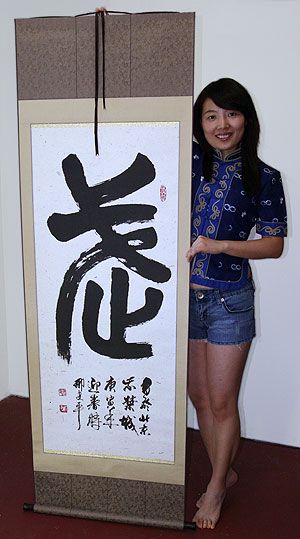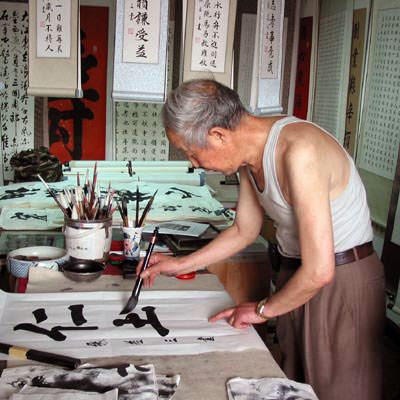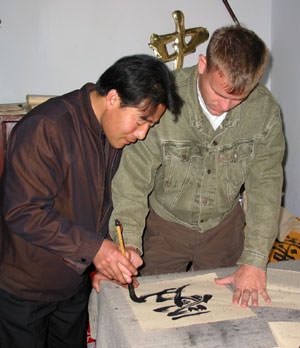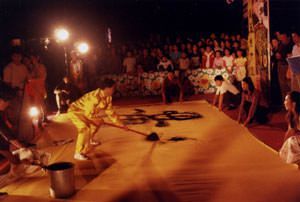Many custom options...
And formats...

Paramartha in Chinese / Japanese...
Buy a Paramartha calligraphy wall scroll here!
Paramartha
波羅末陀 is the Chinese and Japanese way to write the ancient Sanskrit word Paramārtha or परमार्थ which now means the highest truth, ultimate truth, ultimate reality, or fundamental meaning.
Paramārtha is the name of a famous Buddhist monk born in 499 CE. Paramārtha traveled the world (including Cambodia and territories that are now part of China) to spread the teachings of Buddhism by translating scriptures into the local languages so the truth could be understood by the masses.
So, we should all want to be a Paramārtha who brings the ultimate truth, knowledge, and enlightenment to others.
Not the results for Paramartha that you were looking for?
Below are some entries from our dictionary that may match your Paramartha search...
| Characters If shown, 2nd row is Simp. Chinese |
Pronunciation Romanization |
Simple Dictionary Definition |
真諦 真谛 see styles |
zhēn dì zhen1 di4 chen ti shindai しんだい |
More info & calligraphy: True Essence(1) {Buddh} (esp. しんたい) (See 俗諦) ultimate truth; (2) (esp. しんてい) essence; (person) Paramartha (499-569 CE) |
波羅末陀 波罗末陀 see styles |
bō luó mò tuó bo1 luo2 mo4 tuo2 po lo mo t`o po lo mo to haramada |
More info & calligraphy: Paramartha |
諦 谛 see styles |
dì di4 ti tai たい |
to examine; truth (Buddhism) {Buddh} satya; truth; (given name) Tai To judge, examine into, investigate, used in Buddhism for satya, a truth, a dogma, an axiom; applied to the āryasatyāni, the four dogmas, or noble truths, of 苦, 集, 滅, and 道 suffering, (the cause of its) assembly, the ( possibility of its cure, or) extinction, and the way (to extinction), i.e. the eightfold noble path, v. 四諦 and 八聖道. There are other categories of 諦, e.g. (2) 眞 and 俗 Reality in contrast with ordinary ideas of things; (3) 空, 假 and 中 q.v. (6) by the 勝論宗; and(8) by the 法相宗.; Two forms of statement: (a) 俗諦 saṃvṛti-satya, also called 世諦, 世俗諦, 覆俗諦, 覆諦, meaning common or ordinary statement, as if phenomena were real; (b) 眞諦 paramartha-satya, also called 第一諦, 勝義諦, meaning the correct dogma or averment of the enlightened. Another definition is 王法 and 佛法, royal law and Buddha law. |
倶舍 see styles |
jù shè ju4 she4 chü she kusha |
kośa, 句捨 cask, box, treasury; translated 藏 store, also 鞘 sheath, scabbard; especially the 倶舍論 Abhidharma-kośa-śāstra, v. 阿, composed by Vasubandhu, tr. by Paramārtha and Xuanzang. |
宗派 see styles |
zōng pài zong1 pai4 tsung p`ai tsung pai shuuha / shuha しゅうは |
sect (1) sect; denomination; (2) school (e.g. of poetry) Sects (of Buddhism). In India, according to Chinese accounts, the two schools of Hīnayāna became divided into twentysects. Mahāyāna had two main schools, the Mādhyamika, ascribed to Nāgārjunaand Āryadeva about the second century A. D., and the Yogācārya, ascribed toAsaṅga and Vasubandhu in the fourth century A. D. In China thirteen sectswere founded: (1) 倶舍宗 Abhidharma or Kośa sect, representing Hīnayāna,based upon the Abhidharma-kosa-śāstra or 倶舍論. (2) 成實宗 Satyasiddhi sect, based on the 成實論 Satyasiddhi-śāstra,tr. by Kumārajīva; no sect corresponds to it in India; in China and Japan itbecame incorporated in the 三論宗. (3) 律宗 Vinaya or Discipline sect, basedon 十誦律, 四分律, 僧祗律, etc. (4) 三論宗 The three śāstra sect, based on theMādhyamika-śāstra 中觀論 of Nāgārjuna, theSata-śāstra 百論 of Āryadeva, and theDvādasa-nikāya-śāstra 十二門論 of Nāgārjuna; this schooldates back to the translation of the three śāstras by Kumārajīva in A. D. 409. (5) 涅槃宗 Nirvāṇasect, based upon the Mahāparinirvāṇa-sūtra 涅槃經 tr. byDharmaraksa in 423; later incorporated in Tiantai, with which it had much incommon. (6) 地論宗 Daśabhūmikā sect, based on Vasubandhu's work on the tenstages of the bodhisattva's path to Buddhahood, tr. by Bodhiruci 508,absorbed by the Avataṃsaka school, infra. (7) 淨土宗 Pure-land or Sukhāvatīsect, founded in China by Bodhiruci; its doctrine was salvation throughfaith in Amitābha into the Western Paradise. (8) 禪宗 dhyāna, meditative or intuitional sect, attributed toBodhidharma about A. D. 527, but it existed before he came to China. (9) 攝論宗, based upon the 攝大乘論 Mahāyāna-saṃparigraha-śāstra byAsaṅga, tr. by Paramārtha in 563, subsequently absorbed by the Avataṃsakasect. (10) 天台宗 Tiantai, based on the 法華經 SaddharmapuṇḍarīkaSūtra, or the Lotus of the Good Law; it is aconsummation of the Mādhyamika tradition. (11) 華嚴宗 Avataṃsaka sect, basedon the Buddhāvataṃsaka-sūtra, or Gandha-vyūha 華嚴經 tr. in 418. (12) 法相宗 Dharmalakṣaṇa sect, established after thereturn of Xuanzang from India and his trans. of the important Yogācāryaworks. (13) 眞言宗 Mantra sect, A. D. 716. In Japan twelve sects are named:Sanron, Hossō, Kegon, Kusha, Jōjitsu, Ritsu, Tendai, Shingon; these areknown as the ancient sects, the two last being styled mediaeval; therefollow the Zen and Jōdo; the remaining two are Shin and Nichiren; at presentthere are the Hossō, Kegon, Tendai, Shingon, Zen, Jōdo, Shin, and Nichirensects. |
馬鳴 马鸣 see styles |
mǎ míng ma3 ming2 ma ming memyou / memyo めみょう |
(person) Asvaghosa (approx. 80-150 CE) 阿濕縛窶抄Aśvaghoṣa, the famous writer, whose patron was the Indo-Scythian king Kaniṣka q. v., was a Brahmin converted to Buddhism; he finally settled at Benares, and became the twelfth patriarch. His name is attached to ten works (v. Hōbōgirin 192, 201, 726, 727, 846, 1643, 1666, 1667, 1669, 1687). The two which have exerted great influence on Buddhism are 佛所行讚經 Buddhacarita-kāvya Sutra, tr. by Dharmarakṣa A. D. 414-421, tr. into English by Beal, S.B.E.; and 大乘起信論 Mahāyāna śraddhotpāda-śāstra, tr. by Paramārtha, A.D.554, and by Śikṣānanda, A. D. 695-700, tr. into English by Teitaro Suzuki 1900, and also by T. Richard, v. 起. He gave to Buddhism the philosophical basis for its Mahāyāna development. There are at least six others who bear this name. Other forms: 馬鳴; 阿濕縛窶抄馬鳴比丘; 馬鳴大士; 馬鳴菩薩, etc. |
三法輪 三法轮 see styles |
sān fǎ lún san1 fa3 lun2 san fa lun san bōrin |
The three law-wheels, or periods of the Buddha's preaching, according to Paramārtha, to 嘉祥 Jiaxiang of the 三論 school, and to 玄奘 Xuanzang of the 法相 school. |
三輪教 三轮教 see styles |
sān lún jiào san1 lun2 jiao4 san lun chiao sanrin kyō |
The three periods of the Buddha's teaching as defined by Paramārtha: (a) 轉法輪 the first rolling onwards of the Law-wheel, the first seven years' teaching of Hīnayāna, i.e. the 四諦 four axioms and 空 unreality; (b) 照法輪 illuminating or explaining the law-wheel, the thirty years' teaching of the 般若 prajñā or wisdom sūtras, illuminating 空 and by 空 illuminating 有 reality; (c) 持法輪 maintaining the law-wheel, i.e. the remaining years of teaching of the deeper truths of 空有 both unreality and reality. Also the three-fold group of the Lotus School: (a) 根本法輪 radical, or fundamental, as found in the 華嚴經 sūtra; (b) 枝末法輪 branch and leaf, i.e. all other teaching; until (c) 攝末歸本法輪 branches and leaves are reunited with the root in the Lotus Sutra, 法華經. |
五攝論 五摄论 see styles |
wǔ shè lùn wu3 she4 lun4 wu she lun Goshōron |
A śāstra of Asaṅga 無著, also translated as the 攝大乘論, giving a description of Mahāyāna doctrine; Vasubandhu prepared a summary of it; tr. by 無性 Wuxiang. Translations were also made by Paramārtha and Xuanzang; other versions and treatises under various names exist. |
起信論 起信论 see styles |
qǐ xìn lùn qi3 xin4 lun4 ch`i hsin lun chi hsin lun Kishinron |
Śraddhotpada Śāstra; it is one of the earliest remaining Mahāyāna texts and is attributed to Aśvaghoṣa; cf. 馬鳴; two tr. have been made, one by Paramārtha in A. D. 554, another by Śikṣānanda, circa 700; the first text is more generally accepted, as Chih-i, the founder of Tiantai, was Paramārtha's amanuensis, and 法藏 Fazang (643-712) made the standard commentary on it, the 起信論義記, though he had assisted Śikṣānanda in his translation. It gives the fundamental principles of Mahāyāna, and was tr. into English by Teitaro Suzuki (1900), also by T. Richard. There are several commentaries and treatises on it. |
勝義諦論 胜义谛论 see styles |
shèng yì dì lùn sheng4 yi4 di4 lun4 sheng i ti lun Shōgitai ron |
Paramārtha-satya-śāstra, a philosophical work by Vasubandhu. |
拘那羅陀 拘那罗陀 see styles |
jun à luó tuó jun1 a4 luo2 tuo2 chün a lo t`o chün a lo to Kunarada |
(or拘那羅他); 拘那蘭難陀 ? Guṇarata, name of Paramārtha, who was known as 眞諦三藏, also as Kulanātha, came to China A. D. 546 from Ujjain in Western India, tr. many books, especially the treatises of Vasubandhu. |
眞諦三藏 眞谛三藏 see styles |
zhēn dì sān zàng zhen1 di4 san1 zang4 chen ti san tsang Shintai Sanzō |
Paramārtha 波羅末陀, also called ? Guṇarata 拘那羅陀 or Kulanātha, from Ujjain in western India, who came to China A.D. 546, and is famous as translator or editor, e.g. of the 起信論. |
瞿那末底 see styles |
jun à mò dǐ jun4 a4 mo4 di3 chün a mo ti Gunamatei |
Guṇamati, a native of Parvata, who lived at Valabhī, a noted antagonist of Brahmanism; his 隨相論 was tr. by Paramārtha A.D. 557-669. |
大乘起信論 大乘起信论 see styles |
dà shéng qǐ xìn lùn da4 sheng2 qi3 xin4 lun4 ta sheng ch`i hsin lun ta sheng chi hsin lun Daijō kishin ron |
Mahāyāna- śraddhotpāda-śāstra, attributed to Aśvaghoṣa 馬鳴 (without sufficient evidence), tr. by Paramārtha A.D. 553 and Śikṣānanda between 695-700; there are nineteen commentaries on it. It is described as the foundation work of the Mahāyāna. Tr. into English by Timothy Richard and more correctly by T. Suzuki as The Awakening of Faith. |
The following table may be helpful for those studying Chinese or Japanese...
| Title | Characters | Romaji (Romanized Japanese) | Various forms of Romanized Chinese | |
| Paramartha | 波羅末陀 波罗末陀 | ha ra ma da haramada | bō luó mò tuó bo1 luo2 mo4 tuo2 bo luo mo tuo boluomotuo | po lo mo t`o polomoto po lo mo to |
| In some entries above you will see that characters have different versions above and below a line. In these cases, the characters above the line are Traditional Chinese, while the ones below are Simplified Chinese. | ||||
Successful Chinese Character and Japanese Kanji calligraphy searches within the last few hours...




